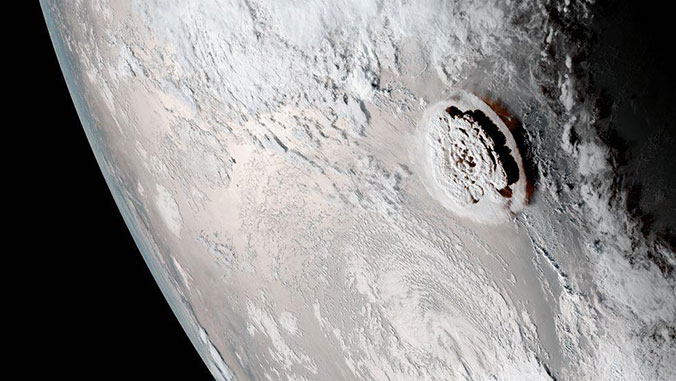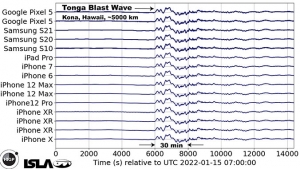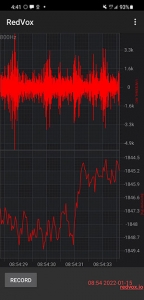
The explosion of the underwater volcano Hunga Tonga-Hunga-Haʻapai on January 15, released a blast “sound” wave that reverberated through Earth’s atmosphere and was recorded around the world by monitoring stations—and smartphones. The devastating eruption produced the most powerful air blast since the 1883 eruption of Krakatoa in Indonesia.
Monitoring systems at the University of Hawaiʻi at Mānoa that continuously listen for infrasound—deep, inaudible atmospheric sound produced by extreme natural events, such as volcanoes, asteroid impacts and intense explosions—recorded the Tonga eruption on traditional infrasound and pressure sensors, as well as with a network of smartphone sensors, showing that smartphones can record large blasts from thousands of miles away.
Monitoring technology advancement

The Infrasound Laboratory, based in the UH Mānoa School of Ocean and Earth Science and Technology (SOEST), is led by Hawaiʻi Institute of Geophysics and Planetology researcher Milton Garces who has spent more than 25 years developing technology to monitor these deep sounds.
Until the event in Tonga, the 2013 Chelyabinsk meteor over Russia was the largest atmospheric blast recorded in the digital era. The blast intensity of meteor impacts and volcanic eruptions is commonly reported relative to the energy from an equivalent trinitrotoluene (TNT) explosion. At an estimated yield of 500 kilotons of TNT, the Russian meteor blast wave was recorded by conventional geophysical monitoring systems all over Earth. After reviewing the emerging smartphone technology of the time, Garces postulated that on-board microphones and barometer sensors could also record such signals.
“Both smartphone and traditional networks captured unique and extraordinary infrasound measurements in Hawaiʻi from the Tonga eruption,” said Garces. “Not only did the smartphones pick up the direct arrival, but also the multiple circumglobal transits of the air wave. Nine years after the Russian meteor, the Tonga blast demonstrated that on-board smartphone sensors can record large blasts thousands of miles away.”
Free RedVox app expands network

In 2014, the U.S. Department of State supported Garces’ development of the RedVox Recorder smartphone application to detect infrasound from atmospheric blasts. More recently, in support of the nation’s nuclear nonproliferation goals, research funding from the U.S. Department of Energy’s National Nuclear Security Administration has enabled Garces to expand his smartphone technology and enhance capabilities to measure diverse sound and vibration signatures near Earth’s surface, as well as in the upper atmosphere and the ocean.
- Related UH News story: UH Mānoa researchers advance nuclear nonproliferation and education, February 28, 2019
Teams of scientists, engineers, programmers, students and citizens have contributed to mature the technology and make it available to the public. The free RedVox Infrasound Recorder app is available in the Apple App and Android Play stores, and runs on most modern smartphones.
This research is an example of UH Mānoa’s goal of Excellence in Research: Advancing the Research and Creative Work Enterprise (PDF), one of four goals identified in the 2015–25 Strategic Plan (PDF), updated in December 2020.
For more information, see SOEST’s website.
–By Marcie Grabowski

